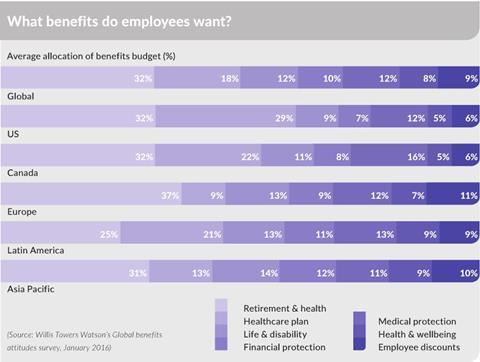
Need to know:
- A global benefits strategy will usually consist of a set of over-riding reward philosophies that are applied differently in different countries.
- A benefits strategy should be designed with clear objectives in mind, including how it aligns with the employer’s business strategy.
- Some benefits, such as share plans or fitness initiatives, can be rolled out across the globe, but others, such as retirement savings or healthcare provision, will differ between locations.
Is it ever possible to create one truly global benefits strategy? And if so, how can an organisation ensure it is market leading?
One of the first steps an employer needs to take when designing a global benefits strategy is to consider the aims and goals that the strategy is to achieve: does it serve a purpose as part of talent attraction and retention, is its aim to shape and encourage the behaviours desired by an employer in its workforce, or is it to present a strong competitive package in front of peers? Designing a strategy comes down to what an employer wants to be, says Ian Milton, senior consultant at Willis Towers Watson. “It’s a way of starting to articulate what it is the organisation would like from employees, and [what makes] it really successful is when [an employer] links it to [its] business strategy in a way to make the two concepts seamless,” he explains.
The reward strategy should contribute to an organisation’s ultimate goal: achieving its business objectives. “It’s that notion of providing a clear definition of performance expectations, and on that basis, what is going to be the reward for said expectations; creating a link to the business strategy for the organisation; and providing a benchmark that the organisation can check overtime to see if it’s still taking it in the right direction,” says Milton.
A challenge for global organisations is how to build a benefits strategy that helps them achieve their business objectives; not every country has a marketplace that will respond well to all reward policies and practices. Milton gives the comparison of an organisation in the US that might favour the notion that ‘cash is king’ and that employees are only as good as their last set of results, with employers in parts of Europe that might operate a paternalistic model that offers pay and benefits, but is not so concerned about bonuses because the culture does not want people to be that aggressive in nature.
While a benefits strategy will be designed around key components, such as internal pay structure, external market data, how performance is rewarded, and how pay and benefits policies are addressed, a global strategy will be influenced by additional factors, says Martha How, reward partner at Aon Employee Benefits. “Those components are influenced by a set of factors, one of which is culture,” she says. “In some cultures, variable pay is an insult, in others, if [an employer] doesn’t do it, [it is] breaking the law.”
Additionally, labour relations, for example, a unionised environment, and how a business is structured will also influence benefits strategy.
Adam Harding, business development manager at Jelf International, says: “If [an employer] is managing [the strategy] from outside of that jurisdiction, [it] needs to make sure that [it is] fully aware of anything that could bite if [it] gets it wrong. If it’s an expat population and competition is quite strong, it’s good to get an idea of what competitors are doing in the market: are [they] providing something that will attract employees to [them] as opposed to another [employer]? Particularly with expat populations, there’s a big element around duty of care and what that employee has access to, [for example, are they] provided with the right information, the right advice and the right benefits to cover them?”
Employers should also ensure they keep an eye on and are able to react to external market influencers. The result of the European referendum vote in June, for example, could impact global benefits strategies in a number of ways, particularly if employers have a globally mobile workforce. Key benefits such as pensions could also be affected (see box below).
Reward and benefits philosophy
A practical step to constructing a global benefits strategy is for an employer to develop a set of over-riding reward philosophies that can then be applied in different countries. “For example, the philosophy might be that [the employer] wants to provide every employee with at least three-times salary life cover because [it] thinks that’s important and [it] cares about the dependants of employees,” says How.
“[It] can have that as the global philosophy but the reality is [it] might not be able to find a provider in certain territories that will deliver that. In certain parts of the Far East it’s very difficult to provide something like that. That’s the challenge from a global point of view; it can’t be particularly granular, it has to be set to principles.”
Although many employers aspire to the notion of being global organisations, pay and benefits for example, are still highly localised issues, says Milton. “That’s simply a fact of life because of the way taxation is treated, because of the ways different marketplaces react,” he says.
This comes down to what it is the reward strategy is trying to support: namely, does the employer have an idea of the elements that it wants all employees to benefit from, wherever they are in the world?
This can be broken down into the monetary elements, such as salary; performance-oriented elements such as bonuses or other forms of incentive; and benefits, and how those elements are then delivered is dependent on what is available in a certain country. For example, flexible benefits is a common practice and widely understood in the UK, but in other countries, the phrase ‘flexible’ may confuse the meaning behind the benefits.
“The strategy then becomes the yardstick by which an organisation is expected to behave in all of its respective marketplaces. [However,] local variation then kicks in because what an [employer] doesn’t want is to end up stamping a one-size-fits-all approach, which by definition could mean [it] ends up overpaying in some marketplaces and underpaying in others, and [it] will end up with employees starting to display behaviour that isn’t necessarily aligned with the business strategy,” says Milton.
The decision of managing a global strategy versus a localised approach is dependent on many factors, namely what works for each individual employer. Charles Cotton, performance and reward adviser at the Chartered Institute of Personnel and Development (CIPD), says: “It tends to be almost a balancing act between organisations that want to control everything, and those types of organisations that leave it up to each country to decide. And in between are the [organisations] that exercise some sort of control and delegate responsibilities to the individual countries. I don’t think any model is necessarily better than the other, it’s just what works for the organisation at the time.”
Cross-border benefits
There are some benefits that easily cross borders and can be rolled out across multiple countries, such as share schemes, fitness initiatives and recognition schemes, although these may look slightly different in different regions. “If someone comes up with a brilliant idea, whether they are in Hong Kong or Alaska, [an employer] can come up with a recognition plan that would work in both territories,” says How.
Pensions can look very different across the globe, and although it may have a different title, many countries offer schemes in some form. In France, it fundamentally has the state system, while in the UK it is standard to also pay into private plans. “In parts of the Middle East where there is very little tax, the way employers provide pensions is through various types of savings plans,” says How.
Almost all regions have some form of retirement-type structure in place, ranging from the employee-invested 401K plan in the US through to wholly state provided and cash lump sums when somebody retires. “In theory, with pensions, [an employer] looks at the aim: if the aim [it] is trying to achieve through a pension is retirement, [it] would have a retirement plan in certain countries through a pension, in others it may be through another savings vehicle,” says Cotton.
“Similarly, with medical, [it] might say everyone will need cover, but does [it] leave it to each country to make its own arrangements, or say ‘we’ll do it ourselves at a central level, and possible get economies of scale, especially with a stop-loss pooling arrangement’.”
An employer’s budget will play a huge part in determining which benefits it will offer globally, and whether it has the resources in house or will need to pay for the resources of a broker to manage the processes.
Strategy benchmarking
Many organisations spend time and effort developing a global employer brand: to this end they will want their benefits offering to be the best in market to support this. However, with so many factors involved in a global strategy, offering a market-leading package is not always a clear cut operation. “[An employer] could argue market leading is if it’s paying for the best pension, healthcare [and so on], but then that’s looking at it component by component rather than as a whole,” says How. “Market leading might be how the [global employer brand] is presented and communicated to employees, and how that communication and brand links to business strategy and values.”
Benchmarking and networking with peers can be a good measure of how an employer’s global benefits strategy shapes up in the market, and offer a starting point from which to develop further. Deborah Rees, director of consulting at Innecto Rewards Consulting, says: “[Employers] are looking for the legal minimum to make sure it is legally compliant, then beyond that: what is the norm? What do the majority offer? Then, thinking ‘what sort of organisation are we? Do we favour people making their own choices about benefits and buying what they want, or is it a more paternalistic style?’”
What is considered a market-leading strategy is subjective to each organisation and the needs of its workforce. Whatever an employer’s measure of success, an effective strategy will likely be one that brings together performance, grade structures, benefits and initiatives under one philosophy, thereby encouraging behaviours that reflect the organisation’s values, culture and business strategy.

Research stats:
- 55% of Europe, Middle East and Africa (EMEA) employers are more likely to manage health initiatives locally, compared to 28% globally and 17% regionally.
- 94% agree that employers are responsible for influencing employee health and changing behaviours
- 56% connect their insurable employee benefits with their health strategy
(Source: Aon Employee Benefits’ EMEA Health survey report 2016, May 2016)

Viewpoint: How Brexit could affect pension schemes
Funding levels in defined benefit (DB) occupational pension schemes have caused immediate concern, with falling gilt yields increasing deficits significantly. Employers with open DB schemes may consider the Brexit vote the trigger to replace DB accrual with a defined contribution (DC) arrangement for the future.
Also important is the financial strength, covenant, of sponsoring employers, which should expect increased engagement with trustees keen to understand the impact of Brexit on business.
In current market conditions, many cash equivalent transfer values (CEVTs), the value of a member’s DB benefits on a transfer-out, have increased. Employers should ensure trustees manage cash flow to cope with any increased demands and to avoid forced asset sales in sub-optimal conditions. Trustees might also consider scaling back CETVs to reflect funding deficits.
Conversely, the weaker pound can benefit schemes holding overseas assets and, for non-UK employers, there may be an opportunity to reduce scheme deficits at a lower cost. For employers considering managing liabilities through bulk annuities, market volatility can create advantageous pricing; however, preparing to move quickly is key.
Investment volatility also affects DC schemes. Employers should encourage DC trustees, or their group personal pension provider, to review whether the investment options, especially the default strategy, offered to employees remain appropriate.
What of EU-derived pension requirements? Some are expected to stay in any event, including anti-discrimination provisions and data protection regulation. Depending on the UK’s future relationship with the EU, potential ‘Brexit bonuses’ include greater clarity on: reclaiming VAT on pension scheme expenses; equalising guaranteed minimum pensions between men and women; and what pension obligations pass to a new employer on a business transfer.
Attempts to subject occupational schemes to ‘Solvency II-style’ funding requirements have so far been rebuffed but may rise again, with negative consequences for sponsoring employers if the UK remains within the remit of EU law, for example, as a member of the European Economic Area.
Jill Clucas is counsel at Hogan Lovells International

Case study: Withers reviews global benefits offering
Global benefits is currently a hot topic for law firm Withers; it has opened six new international offices in the past 18 months and hired many new employees.
Working with its benefits consultants, Willis Towers Watson, it has looked at ways in which it can improve its global offering over the coming year.
Sharon Tebb, compensation and benefits manager at Withers, says: “There is a lot to think about and do when working with benefits in multiple locations, it can be a bit of a minefield to say the least, especially for a small compensation and benefits team, and valuable advice on the integration of a global plan can really help you nail down those all important factors.
“A good global plan can help define strategy to benefits, eligibility and a consistent approach to total reward, as well as streamlining HR processes, which is why Withers is currently reviewing the key points with Willis Towers Watson.”
These key points include ensuring that policies are fully compliant in local territories, for example for benefits such as group income protection, life assurance and private medical insurance (PMI).
The organisation also wants to ensure it offers attractive benefits in line with and, where possible, above and beyond those of its competitors so that it can attract and retain key talent and, if there is a business need, encourage its employees to re-locate, temporarily or permanently, to its office locations.
Tebb adds: “Where possible, [it's about] linking plans together to help to drive down premiums through greater insurer relationships and economies of scale. Time spent looking at the possibilities of linkage and the power of numbers can really help with that all-important 'benefits budget and spend'.”
Withers recognises the difficulty that can be involved in setting up group schemes when a new office may not always initially have the minimum headcount that a benefits insurer requires. Linkage of plans can help reduce the need for expensive, temporary individual cover, which can also be messy from an administrative perspective, says Tebb.

Viewpoint: Key factors in creating a global benefits strategy
Consider, first of all, the desired outcome: an effective global benefits strategy provides a framework for benefit plan design in all countries of operation. It will help align practices with shared objectives, and centralising structures may bring about significant efficiencies, reducing administration and cost. The global benefits strategy should be aligned to the [organisation's] values, and overall direction. For example, a strongly paternalistic [organisation] may require a greater degree of consistency in benefits even if that involves additional cost. Another [organisation] may simply seek to remain competitive. Many consider benefits key to the employer brand.
Benefits offered still vary significantly by geography, even within the same industry. The global benefits strategy will determine the extent that the [organisation’s] employee benefits lead or follow the market in any given country. A wholly consistent offering will certainly result in benefits above market in some cases. Another approach may be to aim for consistent alignment with the local market, rather than offering the same benefits everywhere. An [organisation] with a strong need for talent may wish to target a higher level of benefits in order to attract and retain the right people. Other [organisations] may be content to track the market with a minimum offering. In any case, it is important to take account of local legislative requirements, tax, and culture.
Whatever the direction, the global benefits strategy should be straightforward enough to be able to communicate clearly as part of an overall reward strategy. Finally, there should be sufficient flexibility to cover a degree of change; a global benefits strategy is for the long term.
Sally Hart is executive director of the International Benefits Network, a network of independent benefit consulting firms around the world
















